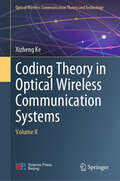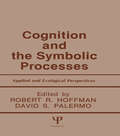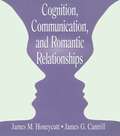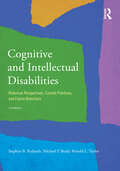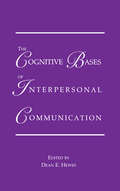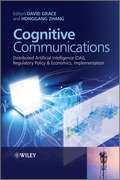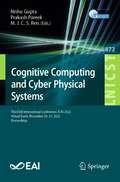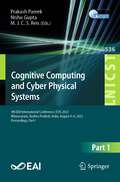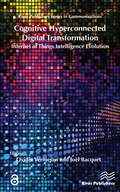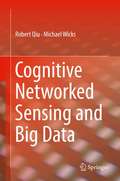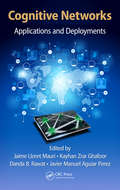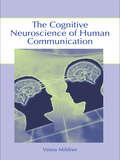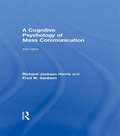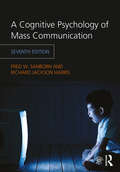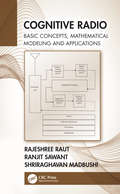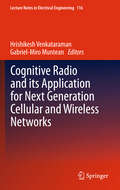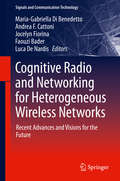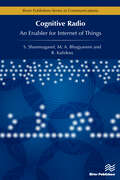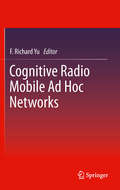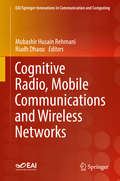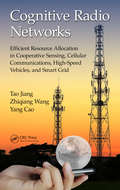- Table View
- List View
Coding Theory in Optical Wireless Communication Systems: Volume II (Optical Wireless Communication Theory and Technology)
by Xizheng KeThis book focuses on optical-wireless communication systems. It summarizes the author's optical-wireless communication coding work while carrying out pertinent scientific research programs. The primary topics covered in the book are channel coding, coding modulation, error control (channel coding), and channel equalization. The author's mathematical analysis and experimental studies on the key theoretical issues are discussed in the book. One of the book's outstanding aspects is its thorough and methodical discussion of practical optical-wireless communication challenges. This makes the book especially appealing to readers who are eager to learn about applicable solutions in this area. Researchers, engineers, and graduate students in the subject of telecommunications can all profit from the book. It is appropriate for senior undergraduates, lecturers at colleges and universities, graduate students, and engineering and technical workers involved in optical communication.
Coding with Coda: Beautiful Development in One Window
by Eric J GruberLike to build websites in the wild with your MacBook? This concise hands-on guide introduces you to the ideal editor: Coda 2. Rather than clutter your screen with shell access, a separate CSS editor, and a version control app, you’ll discover how Coda’s "one-window web development" bundles everything into one neat application. Take Coda on a trial run, then learn step-by-step how to configure each feature to fit your working style. You’ll find out firsthand how Coda will save you time and effort on your next project.Get to know Coda’s workflow by building a sample siteDelve into features such as the tab bar, path bar, sidebar, and Sites viewSet up your own development environment—and dig deeper into the editor’s optionsGet tips for taking full advantage of the text and MySQL editorsCreate a Git or Subversion repository for source control managementLearn the finer points of sharing project documents across a networkDiscover the built-in reference books, and learn how to extend Coda
The Coffee-Table Book in the Post-War Anglophone World (New Directions in Book History)
by Christine ElliottThe Coffee-Table Book in the Post-War Anglophone World argues that coffee-table books appeared and became popular in the post-war era at the convergence of three important developments: advances in full colour printing technology, social change, and publishing entrepreneurism and innovation. Examining the coffee-table book through a book history lens acknowledges their significant contribution to post-war visual culture and illustrated publishing. Focussing on post-war America, Great Britain, and Australia during the “golden age” era of the 1950s, 1960s, and 1970s, this history of the coffee-table book takes an interdisciplinary approach to put the coffee-table book in context in regards to materiality, format, printing, status, and genre.
Cognition and the Symbolic Processes: Applied and Ecological Perspectives
by Robert R. Hoffman David S. PalermoThis volume is a festschrift dedicated to James J. Jenkins, a pioneer in many areas of experimental psychology. It has three major goals: to provide a forum for debate on current theoretical issues in cognitive psychology, to capture the "state of the art" in reviews of research methods and results, and to generate ideas for new research directions and methodologies. Contributors -- including Jenkins' former students and present colleagues -- ponder fundamental questions such as: * How do people learn to read? * What happens during the processes of speech perception? * How do people acquire problem solving skills? * How do cognitive and motor skills develop and integrate with one another? Many chapters focus specifically on ecological and applied cognitive psychology. Specific topics covered include visual and speech perception, language, memory, motivation, child development, problem solving, and pedagogy.
Cognition, Communication, and Romantic Relationships (LEA's Series on Personal Relationships)
by James M. Honeycutt James G. CantrillCognition, Communication, and Romantic Relationships focuses on the role of memory, communication, and social cognition in the development of romantic relationships. The authors review developmental models of communication and examine criticisms of these models. They also explore the stages through which relationships escalate and deteriorate, and consider the processes for such activities as meeting new people, dating, sexual intercourse, and terminating relationships. Differences between men and women are discussed throughout the text, in light of current research supporting systematic gender differences in how people think about romance and relationships. As an extended analysis and research review of how thinking about romance influences and is influenced by communicative processes, this text offers a deeper understanding of the cognitive and communicative factors involved in relationship processes. It is designed for use in courses on interpersonal relationships and intimate relations in social psychology, communication, counseling psychology, clinical psychology, and sociology.
Cognitive and Intellectual Disabilities: Historical Perspectives, Current Practices, and Future Directions
by Ronald L. Taylor Stephen B. Richards Michael P. BradyCognitive and Intellectual Disabilities: Historical Perspectives, Current Practices, and Future Directions provides thorough coverage of the causes and characteristics of cognitive and intellectual disabilities (formerly known as mental retardation) as well as detailed discussions of the validated instructional approaches in the field today. Features include: A companion website that offers students and instructors learning objectives, additional activities, discussion outlines, and practice tests for each chapter of the book. An up-to-date volume that reflects the terminology and criteria of the DSM-V and is aligned with the current CEC standards. Teaching Applications: presents the strongest coverage available in any introductory text on instructional issues and applications for teaching students with cognitive and intellectual disabilities. A unique chapter on "Future Issues" that explores the philosophical, social, legal, medical, educational, and personal issues that professionals and people with cognitive and intellectual disabilities face. This comprehensive and current introductory textbook is ideally suited for introductory or methods courses related to cognitive and intellectual disabilities.
The Cognitive Bases of Interpersonal Communication (Routledge Communication Series)
by Dean E. HewesOur interpretations of the world we live in, and the people and institutions that comprise it, are acquired through complex interactions among what we believe to be true, what the world is, and/or what others think it is. Understanding those complex interactions is one of the most important goals of the social sciences. Of the many disciplines that have contributed to that understanding, two take center stage in this book -- psychology and communication. This volume's purpose is to reconnect the partially isolated environments of social psychology and communication. To do so, it utilizes four building blocks: * the cognitive foundations of interpersonal communication as it might be studied from a social psychological perspective * insiders' views of interpersonal communication from a cognitive psychological standpoint * insiders' approaches to interpersonal communication from an AI perspective * a critique of the cognitive enterprise that reflects the strong philosophical grounding of communication. Overall, the chapters typify some of the most interesting cognitive work done in the study of interpersonal communication. As such, the book should promote productive dialogue across disciplinary boundaries and stimulate further work within the field of interpersonal communication.
Cognitive Communications
by Honggang Zhang David GraceThis book discusses in-depth the concept of distributed artificial intelligence (DAI) and its application to cognitive communicationsIn this book, the authors present an overview of cognitive communications, encompassing both cognitive radio and cognitive networks, and also other application areas such as cognitive acoustics. The book also explains the specific rationale for the integration of different forms of distributed artificial intelligence into cognitive communications, something which is often neglected in many forms of technical contributions available today. Furthermore, the chapters are divided into four disciplines: wireless communications, distributed artificial intelligence, regulatory policy and economics and implementation. The book contains contributions from leading experts (academia and industry) in the field.Key Features:Covers the broader field of cognitive communications as a whole, addressing application to communication systems in general (e.g. cognitive acoustics and Distributed Artificial Intelligence (DAI)Illustrates how different DAI based techniques can be used to self-organise the radio spectrumExplores the regulatory, policy and economic issues of cognitive communications in the context of secondary spectrum accessDiscusses application and implementation of cognitive communications techniques in different application areas (e.g. Cognitive Femtocell Networks (CFN)Written by experts in the field from both academia and industryCognitive Communications will be an invaluable guide for research community (PhD students, researchers) in the areas of wireless communications, and development engineers involved in the design and development of mobile, portable and fixed wireless systems., wireless network design engineer. Undergraduate and postgraduate students on elective courses in electronic engineering or computer science, and the research and engineering community will also find this book of interest.
Cognitive Computing and Cyber Physical Systems: Third EAI International Conference, IC4S 2022, Virtual Event, November 26-27, 2022, Proceedings (Lecture Notes of the Institute for Computer Sciences, Social Informatics and Telecommunications Engineering #472)
by Nishu Gupta Prakash Pareek M. J. C. S. ReisThis proceedings constitutes the post-conference proceedings of the 3rd EAI International Conference on Cognitive Computing and Cyber Physical Systems, IC4S 2022, held at Vishnu Institute of Technology, Bhimavaram in Andhra Pradesh, India, in November 26-27, 2022. The theme of IC4S 2022 was: cognitive computing approaches with data mining and machine learning techniques. The 22 full papers were carefully reviewed and selected from 88 submissions. The papers are clustered in thematical issues as follows: machine learning and its applications; cyber security and networking; image processing; IoT applications; smart city eco-system and communications.
Cognitive Computing and Cyber Physical Systems: 4th EAI International Conference, IC4S 2023, Bhimavaram, Andhra Pradesh, India, August 4-6, 2023, Proceedings, Part II (Lecture Notes of the Institute for Computer Sciences, Social Informatics and Telecommunications Engineering #537)
by Prakash Pareek Nishu Gupta M. J. C. S. ReisThis 2-volume set constitutes the post-conference proceedings of the 4th International Conference on Cognitive Computing and Cyber Physical Systems, IC4S 2023, held in Bhimavaram, Andhra Pradesh, India, during August 4-6, 2023. The theme of IC4S 2023 was: cognitive approaches with machine learning and advanced communications. The 70 full papers were carefully reviewed and selected from 165 submissions. The papers are clustered in thematical issues as follows: machine learning and its applications; cyber security and signal processing; image processing; smart power systems; smart city eco-system and communications.
Cognitive Computing and Cyber Physical Systems: 4th EAI International Conference, IC4S 2023, Bhimavaram, Andhra Pradesh, India, August 4-6, 2023, Proceedings, Part I (Lecture Notes of the Institute for Computer Sciences, Social Informatics and Telecommunications Engineering #536)
by Prakash Pareek Nishu Gupta M. J. C. S. ReisThis 2-volume set constitutes the post-conference proceedings of the 4th EAI International Conference on Cognitive Computing and Cyber Physical Systems, IC4S 2023, Bhimavaram, Andhra Pradesh, India, during August 4-6, 2023. The theme of IC4S 2023 was: cognitive approaches with machine learning and advanced communications. The 70 full papers were carefully reviewed and selected from 165 submissions. The papers are clustered in thematical issues as follows: machine learning and its applications; cyber security and signal processing; image processing; smart power systems; smart city eco-system and communications.
Cognitive Computing for Risk Management (EAI/Springer Innovations in Communication and Computing)
by Sasmita Rani Samanta Pradeep Kumar Mallick Prasant Kumar Pattnaik Jnyana Ranjan Mohanty Zdzislaw PolkowskiThis book presents applications of cognitive management and cognitive computing in the fields of risk management, cognitive fraud detection, and in business decision making. The book provides insights on how cognitive management and cognitive computing enable businesses to quickly augment human intelligence and help humans perform tasks better. For example, the authors describe how by analyzing patterns in big data, small data, and "dark data," cognitive technologies can detect human behavior and suggest options for personalizing of products and services. The book studies companies in industries such as automotive, airline, health care, retail, wealth management, and litigation who have adopted these approaches.Presents applications of cognitive computing and cognitive management used in augmenting and empowering business decisions;Shows how to employ the Internet of Things in businesses using a cognitive management framework;Discusses technical aspects and alternatives to traditional tools, algorithms, and methodologies in cognitive computing.
Cognitive Hyperconnected Digital Transformation: Internet of Things Intelligence Evolution
by Ovidiu Vermesan Joël BacquetCognitive Hyperconnected Digital Transformation provides an overview of the current Internet of Things (IoT) landscape, ranging from research, innovation and development priorities to enabling technologies in a global context. It is intended as a standalone book in a series that covers the Internet of Things activities of the IERC-Internet of Things European Research Cluster, including both research and technological innovation, validation and deployment. The book builds on the ideas put forward by the European Research Cluster, the IoT European Platform Initiative (IoT-EPI) and the IoT European Large-Scale Pilots Programme, presenting global views and state-of-the-art results regarding the challenges facing IoT research, innovation, development and deployment in the next years. Hyperconnected environments integrating industrial/business/consumer IoT technologies and applications require new IoT open systems architectures integrated with network architecture (a knowledge-centric network for IoT), IoT system design and open, horizontal and interoperable platforms managing things that are digital, automated and connected and that function in real-time with remote access and control based on Internet-enabled tools. The IoT is bridging the physical world with the virtual world by combining augmented reality (AR), virtual reality (VR), machine learning and artificial intelligence (AI) to support the physical-digital integrations in the Internet of mobile things based on sensors/actuators, communication, analytics technologies, cyber-physical systems, software, cognitive systems and IoT platforms with multiple functionalities. These IoT systems have the potential to understand, learn, predict, adapt and operate autonomously. They can change future behaviour, while the combination of extensive parallel processing power, advanced algorithms and data sets feed the cognitive algorithms that allow the IoT systems to develop new services and propose new solutions. IoT technologies are moving into the industrial space and enhancing traditional industrial platforms with solutions that break free of device-, operating system- and protocol-dependency. Secure edge computing solutions replace local networks, web services replace software, and devices with networked programmable logic controllers (NPLCs) based on Internet protocols replace devices that use proprietary protocols. Information captured by edge devices on the factory floor is secure and accessible from any location in real time, opening the communication gateway both vertically (connecting machines across the factory and enabling the instant availability of data to stakeholders within operational silos) and horizontally (with one framework for the entire supply chain, across departments, business units, global factory locations and other markets). End-to-end security and privacy solutions in IoT space require agile, context-aware and scalable components with mechanisms that are both fluid and adaptive. The convergence of IT (information technology) and OT (operational technology) makes security and privacy by default a new important element where security is addressed at the architecture level, across applications and domains, using multi-layered distributed security measures. Blockchain is transforming industry operating models by adding trust to untrusted environments, providing distributed security mechanisms and transparent access to the information in the chain. Digital technology platforms are evolving, with IoT platforms integrating complex information systems, customer experience, analytics and intelligence to enable new capabilities and business models for digital business.
Cognitive Networked Sensing and Big Data
by Michael Wicks Robert QiuWireless Distributed Computing and Cognitive Sensing defines high-dimensional data processing in the context of wireless distributed computing and cognitive sensing. This book presents the challenges that are unique to this area such as synchronization caused by the high mobility of the nodes. The author will discuss the integration of software defined radio implementation and testbed development. The book will also bridge new research results and contextual reviews. Also the author provides an examination of large cognitive radio network; hardware testbed; distributed sensing; and distributed computing.
Cognitive Networks: Applications and Deployments
by Jaime Lloret Mauri Kayhan Zrar Ghafoor Danda B. Rawat Javier Manuel Aguiar PerezA cognitive network makes use of the information gathered from the network in order to sense the environment, plan actions according to the input, and make appropriate decisions using a reasoning engine. The ability of cognitive networks to learn from the past and use that knowledge to improve future decisions makes them a key area of interest for
The Cognitive Neuroscience of Human Communication
by Vesna MildnerThis is a book about speech and language. It is primarily intended for those interested in speech and its neurophysiological bases: phoneticians, linguists, educators, speech therapists, psychologists, and neuroscientists. Although speech and language are its central topic, it provides information about related topics as well (e.g. structure and functioning of the central nervous system, research methods in neuroscience, theories and models of speech production and perception, learning, and memory). Data on clinical populations are given in parallel with studies of healthy subjects because such comparisons can give a better understanding of intact and disordered speech and language functions. There is a review of literature (more than 600 sources) and research results covering areas such as neuroanatomy, neurophysiology, development of the nervous system, sex differences, history of neurolinguistics, behavioral, neuroimaging and other research methods in neuroscience, linguistics and psychology, theories and models of the nervous system function including speech and language processing, kinds of memory and learning and their neural substrates, critical periods, various aspects of normal speech and language processes (e.g. phonetics, phonology, syntax, semantics, reading), bilingualism, speech and language disorders, and many others. Newcomers to the field of neurolinguistics will find it as readable as professionals will because it is organized in a way that gives the readers flexibility and an individual approach to the text. The language is simple but all the technical terms are provided, explained, and illustrated. A comprehensive glossary provides additional information.
A Cognitive Psychology of Mass Communication
by Richard Jackson Harris Fred W. SanbornA Cognitive Psychology of Mass Communication is the go-to text for any course that adopts a cognitive and psychological approach to the study of mass communication. In its sixth edition, it continues its examination of how our experiences with media affect the way we acquire knowledge about the world, and how this knowledge influences our attitudes and behavior. Using theories from psychology and communication along with reviews of the most up-to-date research, this text covers a diversity of media and media issues ranging from commonly discussed topics, such as politics, sex, and violence, to lesser-studied topics, such as sports, music, emotion, and prosocial media. This sixth edition offers chapter outlines and recommended readings lists to further assist readability and accessibility of concepts, and a new companion website that includes recommended readings, even more real-world examples and activities, PowerPoint presentations, sample syllabi, and an instructor guide.
A Cognitive Psychology of Mass Communication
by Fred W. Sanborn Richard Jackson HarrisIn a constantly changing media landscape, A Cognitive Psychology of Mass Communication is the go-to text for any course that examines mass communication from a psychological perspective. Now in its seventh edition, the book continues its exploration of how our experiences with media affect the way we acquire and process knowledge about the world and how this knowledge influences our attitudes and behavior. Updates include end-of-chapter suggestions for further reading, new research and examples for a more global perspective, as well as an added emphasis on the power of social media in affecting our perceptions of reality and ourselves. While including real-world examples, the book also integrates psychology and communication theory along with reviews of the most up-to-date research. The text covers a diversity of media forms and issues, ranging from commonly discussed topics such as politics, sex, and violence, to lesser-studied topics, such as emotions and prosocial media. The accompanying companion website also includes resources for both instructors and students For students: Chapter outlines, summaries, and review questions Useful links For instructors: Guidelines for in-class discussions Sample syllabus Readers will be challenged to become more sensitized and to think more deeply about their own media use as they explore research on behavior and media effects. Written in an engaging, readable style, the text is appropriate for graduate or undergraduate audiences.
Cognitive Radio: Basic Concepts, Mathematical Modeling and Applications
by Rajeshree Raut Ranjit Sawant Shriraghavan MadbushiGlobally considered as one of the key technologies in the field of wireless communications, cognitive radio has the capability to solve the issues related to radio spectrum scarcity with the help of dynamic spectrum allocation. It discusses topics including software defined radio architecture, linear predictive coding, variance fractal compression, optimal Codec design for mobile communication system, digital modulation techniques, spectrum sensing in cognitive radio networks and orthogonal frequency division multiplexing in depth. The text is primarily written for senior undergraduate and graduate students, in learning experimental techniques, designing and implementing models in the field wireless communication.
Cognitive Radio and its Application for Next Generation Cellular and Wireless Networks (Lecture Notes in Electrical Engineering #116)
by Gabriel-Miro Muntean Hrishikesh VenkataramanThis book provides a broad introduction to Cognitive Radio, which attempts to mimic human cognition and reasoning applied to Software Defined Radio and reconfigurable radio over wireless networks. It provides readers with significant technical and practical insights into different aspects of Cognitive Radio, starting from a basic background, the principle behind the technology, the inter-related technologies and application to cellular and vehicular networks, the technical challenges, implementation and future trends. The discussion balances theoretical concepts and practical implementation. Wherever feasible, the different concepts explained are linked to application of the corresponding scheme in a particular wireless standard. This book has two sections: the first section begins with an introduction to cognitive radio and discusses in detail various, inter-dependent technologies such as network coding, software-based radio, dirty RF, etc. and their relation to cognitive radio. The second section deals with two key applications of cognitive radio - next generation cellular networks and vehicular networks. The focus is on the impact and the benefit of having cognitive radio-based mechanisms for radio resource allocation, multihop data transmission, co-operative communication, cross-layer solutions and FPGA-level framework design, as well as the effect of relays as cognitive gateways and real-time, seamless multimedia transmission using cognitive radio.
Cognitive Radio and Networking for Heterogeneous Wireless Networks: Recent Advances and Visions for the Future (Signals and Communication Technology)
by Maria-Gabriella Di Benedetto Faouzi Bader Andrea F. Cattoni Jocelyn Fiorina Luca De NardisThis book, written by leading experts from academia and industry, offers a condensed overview on hot topics among the Cognitive Radios and Networks scientific and industrial communities (including those considered within the framework of the European COST Action IC0902) and presents exciting visions for the future. Examples of the subjects considered include the design of new filter bank-based air interfaces for spectrum sharing, medium access control design protocols, the design of cloud-based radio access networks, an evolutionary vision for the development and deployment of cognitive TCP/IP, and regulations relevant to the development of a spectrum sharing market. The concluding chapter comprises a practical, hands-on tutorial for those interested in developing their own research test beds. By focusing on the most recent advances and future avenues, this book will assist researchers in understanding the current issues and solutions in Cognitive Radios and Networks designs.
Cognitive Radio - An Enabler for Internet of Things (River Publishers Series In Communications Ser.)
by R. Kalidoss M. A. Bhagyaveni K. S. VishvaksenanInternet of Things (IoT) deals with the interconnection of devices that can communicate with each other over the internet. Currently, several smart systems have evolved with the evolution in IoT. Cognitive Radio - an enabler for Internet of Things is a research level subject for all communication engineering students at undergraduate, post graduate and research levels. The contents of the book are designed to cover the prescribed syllabus for one semester course on the subject prescribed by universities. Concepts have been explained thoroughly in simple and lucid language. Mathematical analysis has been used wherever necessary followed by clear and lucid explanation of the findings and their implication. Key technologies presented include dynamic spectrum access, spectrum sensing techniques, IEEE 802.22 and different radio network architectures. Their role and use in the context of mobile broadband access in general is explained, giving both a high level overview and a detailed step by step explanation. The book includes a large number of diagrams, MATLAB examples, thereby enabling the readers to have a sound grasp of the concepts presented and their applications. This book is a must have resource for engineers and other professionals in the telecommunication industry working with cellular or wireless broadband technologies, helping comprehension of the process of utilization of the updated technology to enable being ahead competition.
Cognitive Radio Mobile Ad Hoc Networks
by F. Richard YuCognitive radios (CR) technology is capable of sensing its surrounding environment and adapting its internal states by making corresponding changes in certain operating parameters. CR is envisaged to solve the problems of the limited available spectrum and the inefficiency in the spectrum usage. CR has been considered in mobile ad hoc networks (MANETs), which enable wireless devices to dynamically establish networks without necessarily using a fixed infrastructure. The changing spectrum environment and the importance of protecting the transmission of the licensed users of the spectrum mainly differentiate classical MANETs from CR-MANETs. The cognitive capability and re-configurability of CR-MANETs have opened up several areas of research which have been explored extensively and continue to attract research and development. The book will describe CR-MANETs concepts, intrinsic properties and research challenges of CR-MANETs. Distributed spectrum management functionalities, such as spectrum sensing and sharing, will be presented. The design, optimization and performance evaluation of security issues and upper layers in CR-MANETs, such as transport and application layers, will be investigated.
Cognitive Radio, Mobile Communications and Wireless Networks (EAI/Springer Innovations in Communication and Computing)
by Mubashir Husain Rehmani Riadh DhaouThis book provides an overview of the latest research and development of new technologies for cognitive radio, mobile communications, and wireless networks. The contributors discuss the research and requirement analysis and initial standardization work towards 5G cellular systems and the capacity problems it presents. They show how cognitive radio, with the capability to flexibly adapt its parameters, has been proposed as the enabling technology for unlicensed secondary users to dynamically access the licensed spectrum owned by legacy primary users on a negotiated or an opportunistic basis. They go on to show how cognitive radio is now perceived in a much broader paradigm that will contribute to solve the resource allocation problem that 5G requirements raise. The chapters represent hand-selected expanded papers from EAI sponsored and hosted conferences such as the 12th EAI International Conference on Mobile and Ubiquitous Systems, the 11th EAI International Conference on Heterogeneous Networking for Quality, Reliability, Security and Robustness, the 10th International Conference on Cognitive Radio Oriented Wireless Networks, the 8th International Conference on Mobile Multimedia Communications, and the EAI International Conference on Software Defined Wireless Networks and Cognitive Technologies for IoT.
Cognitive Radio Networks: Efficient Resource Allocation in Cooperative Sensing, Cellular Communications, High-Speed Vehicles, and Smart Grid
by Tao Jiang Yang Cao Zhiqiang WangResource allocation is an important issue in wireless communication networks. In recent decades, cognitive radio-based networks have garnered increased attention and have been well studied to overcome the problem of spectrum scarcity in future wireless communication systems. Many new challenges in resource allocation appear in cognitive radio-based networks. This book focuses on effective resource allocation solutions in several important cognitive radio-based networks, including opportunistic spectrum access networks, cooperative sensing networks, cellular networks, high-speed vehicle networks, and smart grids.
